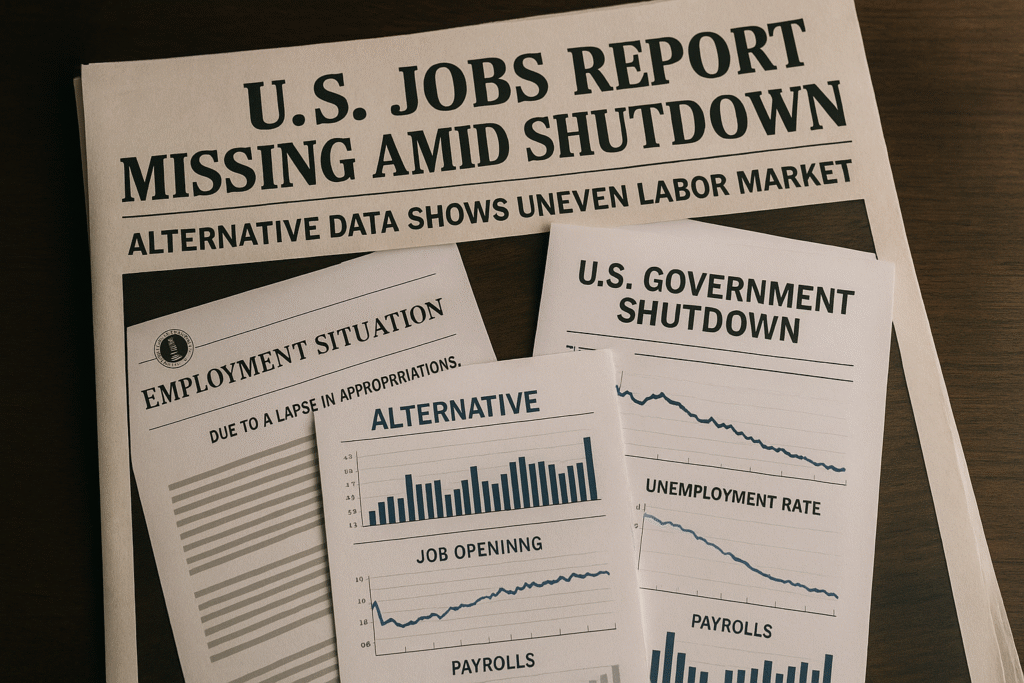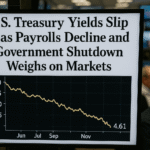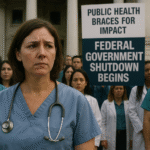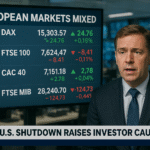By Harshit Washington, D.C., October 4, 2025 – 8:45 AM EDT
Shutdown Silences Official Jobs Report
The first Friday of October typically brings the Bureau of Labor Statistics’ (BLS) closely watched nonfarm payrolls report. This month, however, the release never came. The U.S. government shutdown forced the Labor Department to suspend activity, leaving economists and investors without one of the most critical indicators of the nation’s economic health.
While the BLS has gone dark, alternative data sources indicate that the labor market moved sideways in September, neither collapsing nor accelerating, but showing signs of persistent imbalance.
Alternative Indicators Point to Weak but Stable Market
Dow Jones consensus estimates had predicted nonfarm payroll growth of about 51,000 in September, with the unemployment rate steady at 4.3%. High-frequency data, including private payrolls, job postings, and state-level unemployment claims, suggest sluggish hiring but no major deterioration.
“We fight with the army we have at moments like this,” Chicago Federal Reserve President Austan Goolsbee told CNBC. “Thus far, it still continues to point to a pretty stable labor market.”
The Chicago Fed itself recently unveiled a new labor market dashboard to provide alternative insights, a move that proved timely as official data became unavailable during the shutdown.
Uneven Employment Trends
Even without the BLS release, private-sector data paints a mixed picture. Job postings tracked by Indeed fell 8.9% year over year through September 26, compared with a 5.5% decline reported by the BLS through August.
Healthcare continues to drive job creation, followed by business and professional services, while manufacturing, software development, and parts of the government sector are lagging.
“Right now is a good time to be a nurse, not so good of a time to be a software developer,” said Cory Stahle, senior economist at Indeed. “People taking longer to find jobs is a sign of distress for some households, even if the unemployment rate looks low.”
The unemployment rate held flat at 4.3% in September. A slight uptick would have pushed it to 4.4% — the highest since late 2021, though still historically low.
ADP and Goldman Sachs Fill Data Gap
Private payroll processor ADP reported a loss of 32,000 jobs in September, following a 3,000 decline in August. While ADP data has often diverged from official figures, it is being scrutinized more closely during the shutdown.
The Labor Department’s weekly jobless claims report was also delayed. Goldman Sachs estimated national initial claims at 224,000 based on state filings, slightly higher than the previous week but consistent with trends throughout the year.
Consumer Spending Remains Resilient
Beyond jobs, consumer spending data offers another window into economic momentum. Bank of America reported a 2.2% year-over-year increase in card spending for the week ending September 27. Similarly, Fiserv’s small business index showed sales rising 2.3% in September, consistent with recent months.
Still, small business owners remain cautious. “Right now we see that there are a lot of firms with openings, but very few get filled,” said Bill Dunkelberg, chief economist at the National Federation of Independent Business. “Optimism is high, but when the dust clears, very few jobs actually get created.”
Outlook
The absence of the BLS report underscores how dependent markets are on official economic data. While private sources suggest stability, they also reveal growing fractures across sectors, with healthcare leading and technology lagging.
As the shutdown drags on, the Federal Reserve may face its October policy meeting with limited visibility on the labor market. For now, the job picture remains steady on the surface, but underlying imbalances could become more pronounced if the standoff in Washington continues.







